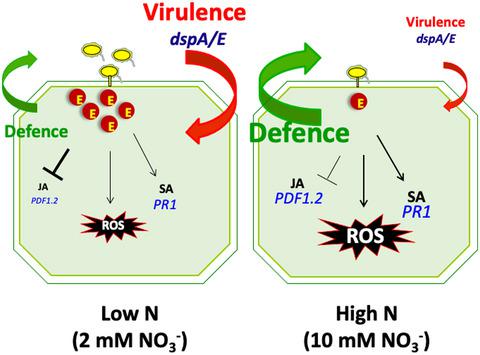当前位置:
X-MOL 学术
›
Mol. Plant Pathol.
›
论文详情
Our official English website, www.x-mol.net, welcomes your
feedback! (Note: you will need to create a separate account there.)
Plant nitrate supply regulates Erwinia amylovora virulence gene expression in Arabidopsis
Molecular Plant Pathology ( IF 4.8 ) Pub Date : 2021-08-12 , DOI: 10.1111/mpp.13114 Mahsa Farjad 1 , Gilles Clément 1 , Alban Launay 1 , Roua Jeridi 1, 2 , Sylvie Jolivet 1 , Sylvie Citerne 1 , Martine Rigault 1 , Marie-Christine Soulie 1, 3 , Sylvie Dinant 1 , Mathilde Fagard 1
Molecular Plant Pathology ( IF 4.8 ) Pub Date : 2021-08-12 , DOI: 10.1111/mpp.13114 Mahsa Farjad 1 , Gilles Clément 1 , Alban Launay 1 , Roua Jeridi 1, 2 , Sylvie Jolivet 1 , Sylvie Citerne 1 , Martine Rigault 1 , Marie-Christine Soulie 1, 3 , Sylvie Dinant 1 , Mathilde Fagard 1
Affiliation

|
We showed previously that nitrogen (N) limitation decreases Arabidopsis resistance to Erwinia amylovora (Ea). We show that decreased resistance to bacteria in low N is correlated with lower apoplastic reactive oxygen species (ROS) accumulation and lower jasmonic acid (JA) pathway expression. Consistently, pretreatment with methyl jasmonate (Me-JA) increased the resistance of plants grown under low N. In parallel, we show that in planta titres of a nonvirulent type III secretion system (T3SS)-deficient Ea mutant were lower than those of wildtype Ea in low N, as expected, but surprisingly not in high N. This lack of difference in high N was consistent with the low expression of the T3SS-encoding hrp virulence genes by wildtype Ea in plants grown in high N compared to plants grown in low N. This suggests that expressing its virulence factors in planta could be a major limiting factor for Ea in the nonhost Arabidopsis. To test this hypothesis, we preincubated Ea in an inducing medium that triggers expression of hrp genes in vitro, prior to inoculation. This preincubation strongly enhanced Ea titres in planta, independently of the plant N status, and was correlated to a significant repression of JA-dependent genes. Finally, we identify two clusters of metabolites associated with resistance or with susceptibility to Ea. Altogether, our data showed that high susceptibility of Arabidopsis to Ea, under low N or following preincubation in hrp-inducing medium, is correlated with high expression of the Ea hrp genes in planta and low expression of the JA signalling pathway, and is correlated with the accumulation of specific metabolites.
中文翻译:

植物硝酸盐供应调节拟南芥解淀粉欧文氏菌毒力基因表达
我们之前表明,氮(N)限制会降低拟南芥对梨火疫病菌(Ea)的抗性。我们发现,低氮条件下细菌抵抗力的降低与质外体活性氧(ROS)积累的降低和茉莉酸(JA)途径表达的降低相关。一致地,茉莉酸甲酯 (Me-JA) 预处理增加了在低氮条件下生长的植物的抗性。同时,我们发现,无毒力的 III 型分泌系统 (T3SS) 缺陷型 Ea 突变体的植物滴度低于野生型。正如预期的那样,Ea 在低氮中,但令人惊讶的是在高氮中却没有。高氮中缺乏差异与野生型 Ea 与在高氮中生长的植物相比,在高氮中生长的植物中 T3SS编码hrp毒力基因的低表达是一致的。低N。这表明在植物中表达其毒力因子可能是非寄主拟南芥中Ea的主要限制因素。为了检验这一假设,我们在接种前将 Ea 在诱导培养基中预孵育,以在体外触发hrp基因的表达。这种预孵育强烈增强了植物中的 Ea 滴度,与植物 N 状态无关,并且与 JA 依赖性基因的显着抑制相关。最后,我们确定了与 Ea 抗性或敏感性相关的两类代谢物。总而言之,我们的数据表明,在低氮条件下或在hrp诱导培养基中预培养后,拟南芥对 Ea 的高敏感性与植物中 Ea hrp 基因的高表达和 JA 信号通路的低表达相关,并且与植物中 Ea hrp基因的高表达和 JA 信号通路的低表达相关。特定代谢物的积累。
更新日期:2021-10-15
中文翻译:

植物硝酸盐供应调节拟南芥解淀粉欧文氏菌毒力基因表达
我们之前表明,氮(N)限制会降低拟南芥对梨火疫病菌(Ea)的抗性。我们发现,低氮条件下细菌抵抗力的降低与质外体活性氧(ROS)积累的降低和茉莉酸(JA)途径表达的降低相关。一致地,茉莉酸甲酯 (Me-JA) 预处理增加了在低氮条件下生长的植物的抗性。同时,我们发现,无毒力的 III 型分泌系统 (T3SS) 缺陷型 Ea 突变体的植物滴度低于野生型。正如预期的那样,Ea 在低氮中,但令人惊讶的是在高氮中却没有。高氮中缺乏差异与野生型 Ea 与在高氮中生长的植物相比,在高氮中生长的植物中 T3SS编码hrp毒力基因的低表达是一致的。低N。这表明在植物中表达其毒力因子可能是非寄主拟南芥中Ea的主要限制因素。为了检验这一假设,我们在接种前将 Ea 在诱导培养基中预孵育,以在体外触发hrp基因的表达。这种预孵育强烈增强了植物中的 Ea 滴度,与植物 N 状态无关,并且与 JA 依赖性基因的显着抑制相关。最后,我们确定了与 Ea 抗性或敏感性相关的两类代谢物。总而言之,我们的数据表明,在低氮条件下或在hrp诱导培养基中预培养后,拟南芥对 Ea 的高敏感性与植物中 Ea hrp 基因的高表达和 JA 信号通路的低表达相关,并且与植物中 Ea hrp基因的高表达和 JA 信号通路的低表达相关。特定代谢物的积累。









































 京公网安备 11010802027423号
京公网安备 11010802027423号